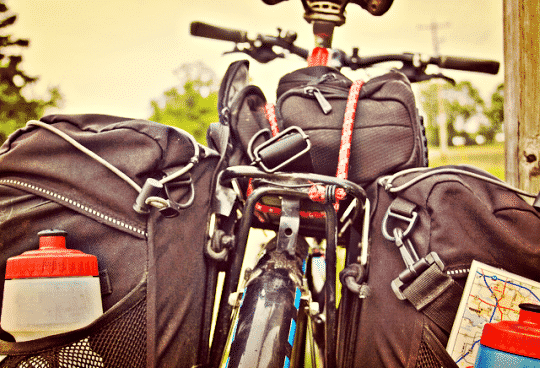
Should you employ a bike to make a hasty escape?
Yes, you should! Because it has distinct advantages over:
- Bug out vehicles
- Walking…
In SHTF, fuel shortages and clogged roads will be a vehicle’s biggest challenge. And while walking is a good last resort, it’s too slow…

Want a free 104 item bug out bag checklist?
Enter your email below to instantly download this Complete Checklist PDF. No purchase necessary. 👇 👇Hiking Vs. Biking
You plan to hike, which avoids the vehicle bug-out challenges. But while hiking is more reliable, it’s both slow and burdensome.
It’s actually the slowest and least efficient way to get from point A to point B (besides maybe crawling).
Hiking is the default last resort bug-out option. But unless you’re disabled, a bug-out bike is an excellent upgrade.
However, for the wrong person, in the wrong setting, could prove deadly.
So, in today’s article, we will explore the advantages and disadvantages in more detail.
We’ll discuss a few of the best components and designs. I’ll even share a few badass upgrades and accessories you need.
Ones that will turn your boring street cruiser into a terrain-slaying bug-out bicycle beast.
Bikes Vs. Traffic Jams
Ever seen a bike traffic jam? Me neither. When roads get crowded, and cars stop, bicycles can slip past unperturbed.
When Highway 69 turns into a parking lot, you’ll be pedaling past the helpless masses to bug out safety.
The bottom line is they’re 1) reliable, 2) easy to operate, 3) easy to maintain, and 4) get you from point A to point B. In this case, point B is your bug-out location.
The Opposite is True For Motorized Vehicles
Americans own millions of bikes. However, almost everyone in America has at least one motorized vehicle.
We are a fossil fuel-addicted society. The only evidence you need of this fact is the advent of drive-through fast food and drive-up ATMs.
I even had a drive-through liquor store in my town, but it has since gone out of business.
With so many people’s default SHTF bugout being a vehicle, fuel shortages will likely occur when things go wrong.
People will hoard what they can get their hands on, and fresh supplies will quickly dwindle.
You may believe you’ll be able to jump in your car and split when the SHTF. The problem is, so does everyone else.
If you live in or near a densely populated area, the roads will likely be clogged with people trying to leave.
Your car or truck may become useless in this scenario. However, you can thread your way out with some basic gear.
In fact, there are probably subtle, narrow paths to sneak your way out of town nearly undetected. You should find all the escape paths in your area.
Maps are usually available at your local bike shop.
While a moving vehicle is the fastest of options, a parked vehicle is the slowest. A bug-out bicycle is faster than walking, and it sure beats being stuck in a massive traffic jam.
RELIABLE Speed
Speed is essential in an SHTF environment.
Depending on where you live and where you’re headed, a bicycle can give you a speedy means of bugging out. And you can carry more gear than you probably think (more on this later).
Besides the inevitable fuel shortages and clogged roads, there will also be spare parts shortages.
The number of unique cars we drive will make getting parts difficult or impossible.
So unless you’ve stocked up on essential spare parts for your vehicle, you may be SOL when the SHTF!
To make matters worse, most new vehicles have complex, computer-controlled onboard systems. Systems that are impossible for regular joes to fix themselves. Maybe you’ll get lucky; maybe nothing will break on your rig for a long time.
But remember, everything eventually breaks, and everything eventually fails.
What’s new today becomes old tomorrow. But bike parts are simple, and don’t need gas.
They are understandable, simple 2-wheel human power.
No finicky computer-controlled parts to leave you high and dry.
What about flat tires and broken chains? Yes, they are common problems, but they are easily fixed.
Even if you’re a complete klutz, basic bicycle repair can be done when push comes to shove.
Another benefit is it can carry a ton of gear and supplies. With panniers (saddlebags) and a trailer, you can transport more than just a bug out bag alone.
Let’s review a few of the main things you’ll need to consider.
- You need to start thinking about the frame, wheels, and components.
- Are you in physical shape for cycling? If you are, great! If not, you’ll need to get there.
- Are you going to modify your bike or buy a ready-to-roll machine?
No Scarcity Problems, Bikes Are Everywhere
You won’t struggle to find a bike if you want one. There are plenty to go around.
You probably already have one; if not, you can easily get one cheaply.
According to Statista,51.4 million Americans have ridden a bicycle in the last 12 months. And bikes related sales bring in around 6.2 billion dollars annually.
Millions of Americans regularly ride for exercise, fun, and transportation.
Bikes are everywhere, and we’ve ridden them our entire lives!
If you have children, chances are they have bikes.
Bikes Are Simple Machines
Bikes are simple compared to most of the new technology we operate in our modern lives. Sure, some newer ones come equipped with advanced accessories and unique mechanisms.
This helps create a smoother ride and improves braking. But, the core mechanics are easily understood by nearly everyone.
No complicated electrical parts or micro-sized mechanical wizardry.
Bikes are essentially 2 tires bolted to a frame and tied together with gears and a chain.
You transfer your energy through 2 pedals, which move the chains and rotate a tire. As I said, It is a very simple concept.
This simple design means the parts are readily available and relatively straightforward to repair.
And as far as operating one, if you’ve learned to ride once, you’ve learned for life. To quote Freddy Mercury,
“Get On Your Bikes and Ride.”

Want a free 104 item bug out bag checklist?
Enter your email below to instantly download this Complete Checklist PDF. No purchase necessary. 👇 👇Materials, Components & Accessories
Frame Material Choices
Let’s assume you’ve decided to get a bug-out bike.
- Where should you start looking?
- What kinds of things should you think about?
Weight and strength are the two most important factors to consider.
Bicycle frames, wheels, and components are all made of different materials.
All the materials have unique weight and strength properties.
Frames
All bikes are built on a frame, which can be of various styles, materials, and geometry.
The frame geometry is what determines what type you have. From a sleek, quick-handling road machine built for speed to a comfortable, relaxed model designed for cruising along the beach.
Or a mountain bike designed to take a beating on even the most rugged terrain.
For our bug-out purposes, a mountain frame geometry is the best.
In terms of weight, strength, and comfort, it’s the frame design you want. Plus, you can add panniers, frame packs, or pull a trailer. You want a frame that’s light.
Nothing will get you bogged down faster than a heavy steel frame with steel rims and components.
The bicycle industry has been trending towards lighter and stronger materials over the past decade. So, let’s look at the types of frame materials and their characteristics.
1. Carbon Steel
Steel is the most common material used.
It is strong, but it is also heavy.
2. Chromoly (Chrome Molybdenum) Steel
This is a lighter type of steel that is stronger than carbon steel. Today, it is widely used in the industry.
It makes the frame tubes thinner, with butted or thickened ends where the tubes are welded.
It has the advantage of being relatively flexible and gives a comfortable ride.
3. Aluminum
Light, strong, stiff aluminum frames have evolved from oversized tubes to thinner ones.
They provide a good alternative to Chromoly or steel.
4. Titanium
Lighter than steel and equally strong, titanium frames are responsive and absorb vibrations well.
Higher in price, titanium frames are found on many high-end bikes.
5. Carbon Fiber
Made from parallel fibers of carbon and laminated with glue, this material makes strong frames. However, it tends to be stiff and difficult to repair.
Still, it’s light and used for building racing and cross-country bikes. It is also expensive.
So, as you can see, there are numerous choices in frame materials. You’ll need to decide what your particular needs are.
Needs such as:
- Distance to your bug-out location
- Your regional terrain
- Your physical conditioning.
Here’s a solid article about frames for even more detailed research.
Components
You want yours to have reliable, high-quality components. Pedals, brakes, derailleurs, cables, handlebars, and wheels all should be top quality.
Local bike shops, internet sources, and eBay are good places to research these components.
Typically, the cheaper the components, the more likely they will fail prematurely or in rugged conditions.
Stripped derailleurs, broken cables, and plastic pedals can really hinder your bug out. Being unable to shift smoothly or having a jumped chain is not acceptable mid-bug out.
Upgraded components are a good place to spend your dollars.
I won’t dive into each component today (sites are dedicated solely to these topics). However, if you aren’t familiar with bicycles or their various parts, talk to people in your local bike shop or start looking on the Internet.
You’ll be amazed at how much information is out there. Bike Nashbar is one of my favorite resources.
It has tons of accessories and information, so feel free to check out its website, www.nashbar.com, when you’re ready to upgrade your components.

Want a free 104 item bug out bag checklist?
Enter your email below to instantly download this Complete Checklist PDF. No purchase necessary. 👇 👇Accessories
Like components, accessories come in all styles and materials, ranging from low to high prices.
The most important accessories for your bike are those for carrying your gear.
Panniers
Panniers, essentially saddlebags, have rigid frames that bolt to the frame and fork.
There are also frame-mounted bags with Velcro straps that fit inside the bike’s main triangle.
Strong Rack
Another useful accessory is a rigid rack that bolts to the seat post of your rig.
Besides panniers and gear bags, you may need lights for night riding. Some are battery-powered, but generator hubs power my favorites.
These setups produce electrical current by using the rotation of the wheels.
Update: E Bikes
This post was originally written in 2015, and while MOST of the information is still 100% relevant, one major bike revolution is underway: E-Bikes!
E-bikes are all the rage nowadays and are perfectly matched for bugging out.
They will:
- Extend your effective range
- Allow you to pack more weight
- Increase your average escape speed!
All positives, with very few downsides here. I mean, you could argue, “If the E-bike runs out of juice, you’re screwed,” but that’s not true.
You can still pedal like a traditional bike when the electronic components are nonfunctional. So you gain a very effective tool, but it doesn’t add any downsides. It’s a win-win.
↓ BIG CITY BUG OUT! [70+ Miles – 112 Kilometers!]
And here’s an example of a E-Bike build:
↓ Bug Out EBike – Rad Runner
Trailers
They even make trailers with a generator hub that produces electricity to charge your radio, lights, or cell phone.
Regarding bike trailers, they are great for hauling gear but can make rugged terrain biking hell.
So, if you know for a fact you will be sticking to roads, then really any small survival trailer that can carry 50+ lbs will do. But if you are going off-road at all, you should check out this solution:
↓ DOM T2 Trailer MV
It’s both single-tracked and rugged.
This is exactly what you need for a trailer. Pretty cool, huh? Even if you don’t need this elaborate system, it’s nice to be aware of some of the available cutting-edge bike gear.
My goal isn’t to list every conceivable gizmo and gadget made for bicycles.
This is to acquaint you with the general concept that a two-wheeled, human-powered bicycle is a very viable bug-out option.
Are You In Good Enough Shape?
If you’re out of shape, riding a bike a long distance is NOT a good idea. Could you realistically bug out on a bike?
Are you in good enough physical shape to get yourself 10, 20, or 40 miles away from home? Can you do that with the extra weight of panniers and a trailer?
Riding a bicycle to your bug-out location may not be an option for everyone.
You have to prepare your body for the physical requirements.
If you’re not in shape, you won’t make it.
Your terrain and local weather will also play a factor.
- Do you live in the Southwest, in the hot and arid desert?
- Or do you live in the middle of suburban sprawl?
- Maybe you live in a densely populated inner city.
- Do you live in the mountains?
Each region has its own set of challenges you need to physically prepare for if you want to bug out via a bicycle.
Modify Your Way To Perfection
As simple as bikes are out of the box, most are not ready for the intensity and challenge of a full bug-out.
The good news is:
It’s not hard to transform an old beater into a badass one with some elbow grease.
Step 1. The Frame
The frame is the most important part of any bicycle.
If it’s heavy and uncomfortable, it’ll be a real drag to ride, especially if you need to distance yourself from your bug-out location.
Bike frames these days are made from traditional steel to aluminum, titanium, and carbon fiber.
Each material has its benefits and drawbacks. So make sure you get a strong but light frame.
No heavy steel frames, or you’ll regret it.
Step 2. High-Quality Components
Replace all the old and inferior components with high-quality, reliable ones.
You will have to spend a bit, but if you’re serious about bugging out on a bike, this is critical to your success.
Step 3. How Much Gear and How To Carry It
Figure out how much gear and supplies you plan to take on your bug out.
Here’s a good set of panniers on Amazon that can carry a lot of gear.
There are lightweight trailers, well-designed racks, and panniers of every size and dimension. There are good light setups for night riding.

Want a free 104 item bug out bag checklist?
Enter your email below to instantly download this Complete Checklist PDF. No purchase necessary. 👇 👇Basic Maintenance and Repair Tools
Before we wrap up , it would be a mistake not to mention maintenance and repair.
You need to learn the basics and be able to fix your bike when parts and components eventually fail. Some repairs you should be able to do is:
- Fix a flat tire by replacing or patching the inner tube
- Replacing worn-out brakes
- Replacing a shot chain
- Fixing a broken chain
- Adjusting and fine-tuning all the components
You also need the basic tools to perform these maintenance functions.
A good set of screwdrivers and Alan wrenches is a must.
Action Plan
A bug-out bike may be the best choice for your specific situation. Or at least it might make for an excellent plan B.
Whichever it is, you should start getting yours ready, just in case.
The way you do this is by:
- Make sure you have a bike with a sufficiently strong but light frame
- Replacing any weak or cheap components with ones that can handle rugged terrain
- Adding as much gear/supply storage as possible
- Adding bug-out bike-recommended accessories
- Stashing some repair components and essential repair tools
- Getting in shape, staying in shape, and practicing your bug out!!
If you do these 6 actions, you’ll have a bike and plan you can rely on when the SHTF.
Jonathan Hands
P.s - I just took this FREE 60-second 'Readiness Score Quiz'👇
AND... I've still got a few gaps in my preps...🤔 But at least, I'm not part of 'The Fragile Masses'. 👍 Find out where YOU stand by answering a few questions...
Photo Credits: Seat Rack / Panniers / Bike Example 1 / Bike Components / Bike With Frame Pack

Recommended Reading
Best Bug Out Bag: The Pack Most-Trusted By Experts
You deserve a bug out bag you can trust; a pack to protect all your gear. Here's how to find a good one and avoid making amateur mistakes.
Bug Out Bag Weight: How To Reduce Every Deadly Pound
Advanced tactics to reduce your bug out bag weight because a heavy bug out pack will slow you down. And a slow getaway can get you killed.
Bug Out Location: How To Find One You Can Afford
There are 7 must-have qualities for a perfect bug out location . I show exactly what they are and how to find an affordable one in minutes...
Bug Out Vehicle: The Best Rigs To Escape The Chaos
A good bug out vehicle will help you make it out of chao to safety FAST. I show you the best options and capabilities to design your own rig.
Bug In Vs Bug Out? Smart Or Guaranteed Death Trap
One of the hardest SHTF decisions is: Bug In vs Bug Out. You should plan for both because there some situations where you may have to leave.
Best Survival Retreat: How To Secure Your Own Safe Haven
Building your own survival retreat is easier and more affordable than you think. Log cabins, dug outs, adobe huts are all great options.








